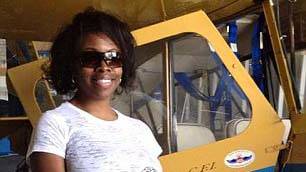The National Transportation Safety Board released a report Monday that provides details of the ill-fated Wings of Alaska flight that crashed in July 2015, killing the pilot.
But the board’s determination of the likely cause of the accident likely will not be released for another few months, NTSB spokesman Eric Weiss said.
“In the (aviation accident) factual report, all of the investigation details are laid out,” Weiss said. “This will then be used to analyze the findings and come up with a probable cause for the crash. We will … say this is what we think happened, and why.”
Fariah Peterson, 45, of Birmingham, Alabama, was the sole fatality when the Cessna 207 she was piloting crashed 18 miles from Juneau on the way to Hoonah, near Point Howard and Point Couverden. Passengers Humberto Hernandez-Aponte, 57, and Sandra Herrera Lopez, 60, of Juneau; Ernestine Hanlon-Abel, 64, of Hoonah; and Jose Vazquez, 15, of Puerto Rico survived the wreck.
The report released by the NTSB on Monday detailed the history of the flight, wreckage and impact information, the weather conditions at the time of the crash, and medical and pathological information on Peterson. A substantial portion of the report reviewed the management and organization of SeaPort Airlines, which owned Wings of Alaska at the time. Wings of Alaska was subsequently purchased by Fjord Flying Services and closed its doors in March of this year.
According to the report, Wings of Alaska Flight 202 left the Juneau airport at about 1:08 p.m. on July 17, 2015, for a 20-minute flight to Hoonah. Peterson had arrived at the company office at noon; this was her first scheduled flight of the day. The company’s flight coordinator reportedly told Peterson that poor weather conditions that morning had canceled most of the earlier flights to Hoonah, with one pilot turning around. The weather had lifted around 10 a.m., however.
The flight coordinator suggested to Peterson that she talk to a pilot who had just returned from Hoonah, but that communication apparently never happened. Peterson was cleared for takeoff and departed with no reported problems; the Juneau Police Department received a 911 call from a passenger about 15 minutes later.
‘He saw the trees coming at the windshield’
One of the passengers told investigators that the turbulence was heavy during takeoff and that the flight route the pilot was taking was “somewhat unusual.” Before the impact, he said, he thought Peterson was trying to climb over the mountain and skirt between clouds.
“He saw the trees coming at the windshield, and the pilot jerked back on the controls, and then he heard a ‘loud boom,’” the report reads. “The next thing he remembered was sitting outside the airplane.”
The passenger said the airplane appeared to be flying normally before the impact.
On-scene examination of the crash site revealed the plane hit a large spruce tree at an elevation of about 1,250 feet, and the fuselage broke apart into two pieces. After the initial impact, the fuselage including the main passenger cabin fell straight down the trunk of the tree and came to rest upside-down, remaining relatively intact. The cockpit, however, was “severely compromised.” Peterson’s autopsy revealed she died of multiple blunt force injuries; toxicology tests showed only the presence of high blood pressure medication.
The report noted that flight coordinators were not provided formal classroom training, just on the job training that did include Alaska-specific items such as unique weather patterns. Use of flight risk assessment forms that had been implemented by SeaPort Airlines appeared to be inconsistent and Peterson did not submit one before departing.
Among other findings noted, the principal operations inspector for SeaPort told investigators that the company did not respect the environmental challenges and questioned whether there was enough oversight from management of pilots new to flying in Alaska. The report noted that a “terrain awareness and warning system” on board the Cessna, which provides warnings of obstacles and either premature or excessive descent, had been manually deactivated to the “inhibit” position.
Peterson was an “experienced pilot” of 13 years, family members said. Peterson was hired as a pilot by SeaPort Airlines a few months before the crash and was assigned to Juneau to help during the tourist season. She had plans to move on to fly in Memphis in September.
Hernandez-Aponte and Vazquez were treated at Bartlett Regional Hospital. Vasquez, who sustained broken ribs and a collapsed lung, was honored by the Coast Guard later that month for his rescue efforts, which included calling for help, providing location coordinates and using smoke signals and a thermal blanket to attract the attention of the arriving helicopter pilot.
Hanlon-Abel and Lopez were flown to Harborview Medical Center in Seattle. Lopez sustained multiple fractures to her arm, ankle, collarbone and ribs. Hanlon-Abel, a Native artist, reportedly suffered features to her arm, ribs, pelvis, hip, and leg.
• Contact reporter Liz Kellar at 523-2246 or liz.kellar@juneauempire.com.

